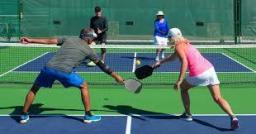PickleballAfter60

Empowering Seniors to Stay Active, Healthy, and Connected Through Exciting Pickleball Sports and Wellness!
Embrace an Active Life After 60
Playing Pickleball
Equipment Types
Pickleball paddles are categorized by their face material (composite, graphite, carbon fiber, fiberglass, wood), core material (polypropylene honeycomb), shape (widebody, elongated, hybrid), weight (lightweight, midweight, heavyweight), and paddle style (control, power, all-court).
Paddle Face Material
The face material affects a paddle's performance and feel:
Carbon Fiber/Graphite: Lightweight and offers excellent touch, control, and spin.
Fiberglass: Provides significant power and is often a good choice for powerful shots.
Composite: A blend of materials that balances weight, power, and control, making it a versatile option.
Wood: The most affordable and durable option, though it is heavier and has a smaller sweet spot.
Paddle Shape
The shape of the paddle determines its reach and sweet spot size:
Widebody: A standard shape with a wide face, offering a larger and more forgiving sweet spot, ideal for control and consistency.
Elongated: Longer and narrower, providing increased reach, power, and spin, though with a smaller sweet spot.
Hybrid: A balance between widebody and elongated shapes, offering a good blend of reach and forgiveness for versatile play.
Paddle Weight
Paddle weight influences power and maneuverability:
Heavyweight: Generates more power but is slower through the air.
Midweight: A balanced option, offering a good mix of power and control.
Lightweight: Easier to control and maneuver, but with less inherent power.
Paddle Style
Paddles can also be categorized by the type of play they are best suited for:
Control Paddles: Prioritize precision, finesse, and soft shots like dinks.
Power Paddles: Designed for aggressive players who like to hit powerful drives and speed-ups.
All-Court Paddles: Offer a balance between power and control, suitable for versatile players.
Back to Menu
Pickleball balls are primarily categorized as either indoor or outdoor, a distinction based on their hole size and material, which affects their flight and bounce. Outdoor balls have smaller holes to reduce wind resistance and are made of harder plastic for durability and speed on abrasive surfaces like concrete or asphalt. Indoor balls have larger holes and softer, more flexible plastic, allowing them to grab the court and provide a more forgiving bounce on softer surfaces such as wood or urethane.
Outdoor Pickleballs
Holes: Have smaller holes, typically around 40, to allow the ball to cut through the wind and fly faster.
Material: Made of a harder, more rigid plastic for increased durability and a faster flight on rough surfaces.
Purpose: Designed to handle abrasive surfaces like concrete and asphalt, which are common for outdoor courts.
Indoor Pickleballs
Holes: Feature larger holes, generally around 26, which help the ball grab the court surface.
Material: Constructed with softer, more flexible plastic to provide a greater feel and a higher, more predictable bounce on indoor courts.
Purpose: Suited for smooth, indoor surfaces like wood, urethane, or vinyl.
Choosing the Right Ball
Surface: The most significant factor is the playing surface. Match the ball to the court to optimize your game.
Experience Level: Beginners may find indoor balls easier to manage on an outdoor court, as they travel slower, but advanced players typically use outdoor balls for competitive outdoor play.
Conditions: Some outdoor balls are designed for different seasons; for example, some harder outdoor balls may crack in colder weather.
Approved Balls: When selecting balls for tournament play, check for an official USA Pickleball (USAPA) approval to ensure they meet required standards.
Back to Menu